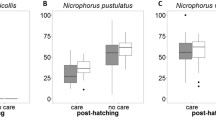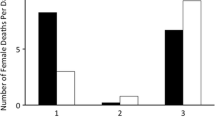Abstract
Burying beetles (Nicrophorus) are model parents among insects, with all studied species known to regurgitate flesh from vertebrate carcasses to their offspring. However, most studies focus on a very few species, yet the interpretation of the function and importance of care is typically generalized to all burying beetles. Here we characterize subtle variation within and between individuals and sexes, and how this variation differs between two species of burying beetle. We find that Nicrophorus orbicollis exhibits low variance, with a normal distribution of parental care provided during peak care periods. In N. vespilloides, however, the distribution is more uniform as values of care are spread across the possible phenotypic spectrum. This suggests that there is stabilizing selection on care in N. orbicollis, but relaxed or disruptive selection in N. vespilloides. Although repeatability was similar between both species, transitions from other care behaviors into feeding were more common in N. orbicollis than N. vespilloides. Thus, while parenting is coarsely similar across the genus, variation in its expression should not be extrapolated to all Nicrophorus. We suggest that subtle variation both within and among species merits greater attention, and could inform us about the factors that lead to different distributions of care.


Similar content being viewed by others
References
Benowitz KM, Moore AJ (2016) Biparental care is predominant and beneficial to parents in the burying beetle Nicrophorus orbicollis (Coleoptera: Silphidae). Biol J Linn Soc. doi:10.1111/bij.12830
Benowitz KM, Moody KJ, Moore AJ (2015) Are species differences in maternal effects arising from maternal care adaptive? J Evol Biol 28:503–509
Boake CRB (1989) Repeatability: its role in evolutionary studies of mating behavior. Evol Ecol 3:173–182
Brodie ED III, Moore AJ, Janzen FJ (1995) Visualizing and quantifying natural selection. Trends Ecol Evol 10:313–318
Cohen J, Cohen P, West SG, Aiken LS (2003) Applied multiple regression/correlation analysis for the behavioral sciences. Erlbaum, Mahwah NJ
Costa JT (2006) The other insect societies. Harvard University Press, Cambridge
Eggert A-K, Müller JK (1997) Biparental care and social evolution in burying beetles: lessons from the larder. In: Choe JC, Crespi JB (eds) The evolution of social behavior in insects and arachnids. Cambridge University Press, Cambridge, pp 216–236
Eggert A-K, Reinking M, Müller JK (1998) Parental care improves offspring survival and growth in burying beetles. Anim Behav 55:97–107
Falconer DS, Mackay TFC (1996) Introduction to quantitative genetics. Prentice Hall, New York
Martin P, Bateson P (2007) Measuring behaviour. Cambridge University Press, Cambridge
Milne LJ, Milne M (1976) Social behavior of burying beetles. Sci Amer 235:84–89
Müller JK, Eggert A-K, Sakaluk SK (1998) Carcass maintenance and biparental brood care in burying beetles: are males redundant? Ecol Entomol 23:195–200
Parker DJ, Cunningham CB, Walling CA, Stamper CE, Head ML, Roy-Zokan EM, McKinney EC, Ritchie MG, Moore AJ (2015) Transcriptomes of parents identify parenting strategies and sexual conflict in a subsocial beetle. Nat Comm 6:8449
Rauter CM, Moore AJ (2002) Quantitative genetics of growth and development time in the burying beetle Nicrophorus pustulatus in the presence and absence of post-hatching parental care. Evolution 56:96–110
Royle NJ, Smiseth PT, Kölliker M (2012) The evolution of parental care. Oxford University Press, Oxford
Schrader M, Jarrett BJM, Kilner RM (2015a) Using experimental evolution to study adaptations for life within the family. Am Nat 185:610–619
Schrader M, Jarrett BJM, Kilner RM (2015b) Parental care masks a density-dependent shift from cooperation to competition among burying beetle larvae. Evolution 69:1077–1084
Scott MP (1998) The ecology and behavior of burying beetles. Annu Rev Entomol 43:595–618
Sikes DS, Venables C (2013) Molecular phylogeny of the burying beetles (Coleoptera: Silphidae: Nicrophorinae). Mol Phylogenet Evol 69:552–565
Smiseth PT (2014) Parental care. In: Shuker DM, Simmons LW (eds) The evolution of insect mating systems. Oxford University Press, Oxford, pp 221–241
Smiseth PT, Moore AJ (2002) Does resource availability affect offspring begging and parental provisioning in a partially begging species? Anim Behav 63:577–585
Smiseth PT, Moore AJ (2004) Signalling of hunger when offspring forage by both begging and self-feeding. Anim Behav 67:1083–1088
Smiseth PT, Darwell CT, Moore AJ (2003) Partial begging: an empirical model for the early evolution of offspring signalling. Proc R Soc B 270:1773–1777
Suzuki S (2015) Recognition of the sex of the parents by young: effects of hunger and biparental care on the begging behavior of Nicrophorus quadripunctatus larvae. J Insect Behav 28:338–344
Tallamy DW, Denno RF (1982) Life history trade-offs in Gargaphia solani (Hemiptera:Tingidae): the cost of reproduction. Ecology 63:616–620
Tallamy DW, Wood TK (1986) Convergence patterns in subsocial insects. Annu Rev Entomol 31:369–390
Trumbo ST (1992) Monogamy to communal breeding: exploitation of a broad resource base by burying beetles (Nicrophorus). Ecol Entomol 17:289–298
Trumbo ST (2012) Patterns of parental care in invertebrates. In: Royle NJ, Smiseth PT, Kölliker M (eds) The evolution of parental care. Oxford University Press, Oxford
Acknowledgments
We thank Brice Hsu and Vic Anderson for assistance with N. orbicollis and N. vespilloides colony maintenance, respectively. Michelle Ziadie, Yukio Yasui, and two anonymous reviewers provided helpful comments on the manuscript. Funding from an NIH Training Grant (T32GM007103) to KMB and an NSF grant (IOS-1354358) to AJM supported this work.
Author information
Authors and Affiliations
Corresponding author
Ethics declarations
All applicable international, national, and/or institutional guidelines for the care and use of animals were followed.
About this article
Cite this article
Benowitz, K.M., McKinney, E.C. & Moore, A.J. Difference in parenting in two species of burying beetle, Nicrophorus orbicollis and Nicrophorus vespilloides . J Ethol 34, 315–319 (2016). https://doi.org/10.1007/s10164-016-0477-5
Received:
Accepted:
Published:
Issue Date:
DOI: https://doi.org/10.1007/s10164-016-0477-5




